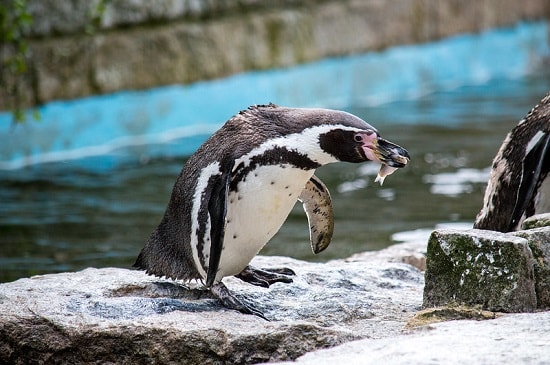What an interesting about penguin?
The penguin is a flightless bird that belongs to the penguin-like order, the penguin family (Lt; Sphenispidae). The word “penguin” has 3 impression at its core. The first includes a combination of the Welsh words pen (head) and gwyn (white), which originally belonged to the extinct wingless eider today. Due to the penguin’s similarity with this bird, the definition was shifted to him. According to the second version, the name penguin was given by the English word pinning, meaning “wing-hairpin” in translation. The third version is the Latin adjective pingis, meaning “fat.”
Penguin – Description, characteristics, structure.
All penguins can swim and dive fully, but they cannot fly at all. On land, the bird feels strange due to the structural features of the body and organs. Penguins have a well-developed body shape with highly developed chest nail muscles, often for a quarter of the total mass. The penguin’s body is fairly well fed, slightly compressed from the sides and covered with feathers. A very large head is not on a movable, flexible and short neck. Penguin’s beak is strong and very sharp.
As a result of evolution and lifestyle, penguins’ wings turned into elastic feathers: when swimming underwater, they move around the shoulder joint according to the principle of a screw. The legs are short and thick, having 4 fingers, which are joined by swimming membranes. Unlike other birds, the penguin’s legs are quite backwards, which forces the bird to keep its body strictly upright while on the ground. To maintain balance, the penguin is helped by a short tail, which has 16–20 hard wings: if necessary, the bird simply rests on it, as if on a stand.
The skeleton of a penguin does not have hollow tubular bones, which is common to other birds: penguin bones are reminiscent of bones of marine mammals. For ideal warm protection, penguins have an amazing inventory of fat with a layer of 2-3 cm.
The penguin layer is thick and dense: separate small and small wings cover the body of a bird like a tile, protecting it from getting wet in cold water. The color of the wings is the same for almost all species – a darker (usually black) posterior and a white belly.
Once a year, the penguin melts: new feathers grow at different speeds, ejecting old feathers, so often the bird undergoes an uncontrolled rip-off during melting. During the melting, penguins are only on the ground, trying to hide from the gust of wind and eat absolutely nothing.
Penguin sizes vary by species: for example, an emperor penguin reaches 117–130 cm in length and weighs from 35 to 40 kg, while a small penguin body length 30–40 cm and weigh 1 kg.
In search of food, penguins are able to spend a lot of time under water, have a thickness of 3 meters and cover a distance of 25–27 km. Penguins in water can reach speeds of 7-10 kmph. Some species dive to a depth of 120–130 m. At a time when penguins do not hunt for mating games and offspring, they are far removed from the coast, sailing up to 1000 km in the sea.
On land, if you need to move quickly, the penguin lies on its belly, and pushes with limbs, quickly gliding over ice or snow. With this strategy of development, penguins create speeds of 3 to 6 km / h. The life expectancy of a penguin in nature is 15–25 year or more. In captivity, this indicator is sometimes increased to 30 years, with the ideal bird keeping.
What do penguins eat?
Penguins eat cephalopods, shellfish and small fish. The bird eats krill, anchovies, Antarctic silverfish, small octopus and squid with delight. For a prey, a penguin can dive 190 to 800–900: it depends on the type of penguin, climatic conditions, and feed requirements. The bird’s oral system works on the principle of a pump: through the beak, it sucks small prey with water.
On average, birds travel a distance of about 27 kilometres while feeding and spend about 80 minutes a day at depths of more than 3 meters.
The geographical distribution of these birds is quite wide, but they prefer coolness. Penguins live in cold regions of the Southern Hemisphere, with their bunches mainly seen in the Antarctic and the suburbs. They also live in southern Australia and South Africa, they are found on practically the entire coastline of South America – from the Falkland Islands to Peru, and on the equator they live in the Galápagos Islands.
Penguin species
Do you know how many species of penguins live on our planet? By modern classification, these birds are added to six genera and nineteen species.
Yellow-eyed penguin
The last member of the yellow colored penguin genus is Megadayptes. The bird lives in the south-east of New Zealand, particularly the South Island, Stewart Island and Campbell and the archipelago of Auckland.
This species is recognized by the yellow eyes that give its name; larger penguins such as the Emperor Penguin can reach up to 70 centimetres, but larger than many other species, they weigh eight kilograms.
Penguins threatened by fishing:
The problem is that penguins are unable to see fishermen in the water, so they get entangled and often drown or get trapped. A recent study demonstrates destruction using disturbances and is the leading cause of death of this species in New Zealand, as more than 75% of the drops have occurred.
Previous research had shown that ships ended up with 35 penguins each year, but in fact this research has only been done on 3% of ships in New Zealand, with a higher number of victims. Biologists in charge of the study fear that, at this rate, the species will become extinct in the coming years.
What can we do?
Many times, when we talk about threatened species, it seems difficult to understand how it relates to us. Intensive fishing is usually done by trawling, which harms pirates and traps many non-commercial species such as penguins. Such fishing affects many other animal species such as dolphins or sharks.
Consumption of meat and fish should be done in moderation, due to the high cost of obtaining it compared to vegetable products. But for the purpose of close consumption and sustainable fishing is even more important; thus, national or even regional fish are the best way to protect the environment and protect this penguin-like species from disappearing.
Penguins with yellow eyes on the verge of extinction
Recent research has shown that the existence of yellow-eyed penguins is in danger if necessary steps are not taken to preserve them. So New Zealand’s famous yellow-eyed penguins may become extinct in the next 25 years due to rising ocean temperatures and climate change.
Key points
- Researchers believe that due to the rising temperature of the oceans, there is a continuous decline in the fertility of these penguins, due to which they will reach the verge of extinction by the year 2060.
- Actually, penguins are highly sensitive to climate change, so efforts should be made to conserve them.
- However, the researchers did not include the incidence of adult penguins dying in this study, such as an incident in 2013 in which more than 60 penguins died.
- Any damage to these penguins with yellow eyes will cause local extinction soon.
Yellow-eyed penguins’ (Megadyptes antipodes) Facts:
- They are the local penguins of New Zealand.
- Earlier it was believed that they are related to the Little Penguin (Eudyptula minor), but molecular studies have shown that they are related to the Eudyptes race penguins just like most other penguins.
- They are mainly piscivorous.
- This species is found in New Zealand’s South Island, Stewart Island, Auckland Island and Campbell Islands.
